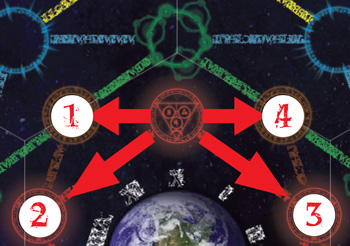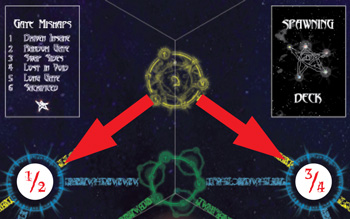Example:
During his movement phase, Greg decides to commit three Cultists and one Servitor to move to an unoccupied Node. He declares his intention and moves his pieces onto the Ley line connecting the two spaces. The Servitor will move across automatically, but Greg must roll 3d6 (i.e. one six-sided die per Cultist) to see whether or not his Cultists make it safely across. He rolls three 1s and must therefore immediately roll again on the Gate Mishaps Table to determine what happens to each token.
He rolls two 2s, and a 6. The 6 is sacrificed to the Void and replaced by another Servitor, which moves directly across. The remaining Cultists have been sent to a Random Gate connecting any of the Nodes adjacent to the Node of Origin.
 Greg now rolls 1d6 to see where his forces go; starting with the Node he intended to travel to as ‘1’ and travelling anti-clockwise around the available Nodes depending on the result of his roll. He rolls a ‘3’ and ends up inadvertently attacking a Node occupied by Pete – such are the vagaries of magic! Greg’s Servitors automatically return to the Node of Origin as, unless they are Serpent folk, they cannot hold the Node and there is nothing to fight. If Greg had not left any Cultists behind in the Node of Origin, both Servitors wink out of existence.
Greg now rolls 1d6 to see where his forces go; starting with the Node he intended to travel to as ‘1’ and travelling anti-clockwise around the available Nodes depending on the result of his roll. He rolls a ‘3’ and ends up inadvertently attacking a Node occupied by Pete – such are the vagaries of magic! Greg’s Servitors automatically return to the Node of Origin as, unless they are Serpent folk, they cannot hold the Node and there is nothing to fight. If Greg had not left any Cultists behind in the Node of Origin, both Servitors wink out of existence.
 If Greg had started in the ring of Ether, his options would be limited to two potential choices, in which case the Node he intended to travel to would be designated either ‘1 – 3 and the other option ‘4 – 6’.
If Greg had started in the ring of Ether, his options would be limited to two potential choices, in which case the Node he intended to travel to would be designated either ‘1 – 3 and the other option ‘4 – 6’.
